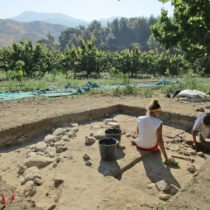The lyre provided the commonest musical accompaniment to the dances in the Bronze Age and Geometric Aegean as the relevant extant iconography suggests. There are two discernible forms of the instrument: a relatively large, eight-shaped Minoan and Mycenean, seven-stringed, version with arms shaped like long necks of water birds, and a smaller, horse-shoe shaped lyre current among Geometric Hellenes, but also evidenced among the Myceneans, and possibly used by the Minoans. This article points out the problems in interpreting the often conflicting iconography of these early types of lyre and seeks to give answers to pertinent organological questions.
Lyre, the Main Dance Instrument in the Hellenic Areas During the Bronze and Iron Age
28 Aug 2012
by Archaeology Newsroom
- A
- A
- A

